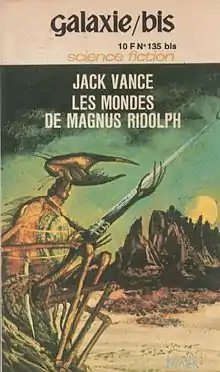

In science fiction and fantasy literature, the term insectoid ("insect-like") denotes any fantastical fictional creature sharing physical or other traits with ordinary insects (or arachnids). Most frequently, insect-like or spider-like extraterrestrial life forms is meant; in such cases convergent evolution may presumably be responsible for the existence of such creatures. Occasionally, an earth-bound setting — such as in the film The Fly (1958), in which a scientist is accidentally transformed into a grotesque human–fly hybrid, or Kafka's famous novella The Metamorphosis (1915), which does not bother to explain how a man becomes an enormous insect — is the venue.
Etymology
The term insectoid denotes any creature or object that shares a similar body or traits with common earth insects and arachnids. The term is a combination of "insect" and "-oid" (a suffix denoting similarity).
History
Insect-like extraterrestrials have long been a part of the tradition of science fiction and fantasy. In the 1902 film A Trip to the Moon, Georges Méliès portrayed the Selenites (moon inhabitants) as insectoid.[1] The Woggle-Bug appeared in L. Frank Baum's Oz books beginning in 1904. Olaf Stapledon incorporates insectoids in his 1937 Star Maker novel.[2] In the pulp fiction novels, insectoid creatures were frequently used as the antagonists threatening the damsel in distress.[3] Notable later depictions of hostile insect aliens include the antagonistic "Arachnids", or "Bugs", in Robert A. Heinlein's novel Starship Troopers (1959)[4] and the "buggers" in Orson Scott Card's Ender's Game series (from 1985).[5]
The hive queen has been a theme of novels including C. J. Cherryh's Serpent's Reach (1981)[6] and the Alien film franchise (from 1979).[7] Insectoid sexuality has been addressed in Philip Jose Farmer's The Lovers (1952)[8] Octavia Butler's Xenogenesis novels (from 1987)[9] and China Miéville's Perdido Street Station (2000).[10]
Analysis
The motif of the insect became widely used in science fiction as an "abject human/insect hybrids that form the most common enemy" in related media.[11] Bugs or bug-like shapes have been described as a common trope in them, and the term 'insectoid' is considered "almost a cliche" with regards to the "ubiquitous way of representing alien life".[12]
In expressing his ambivalence with regard to science fiction, insectoids were on his mind when Carl Sagan complained of the type of story which "simply ignores what we know of molecular biology and Darwinian evolution.... I have...problems with films in which spiders 30 feet tall are menacing the cities of earth: Since insects and arachnids breathe by diffusion, such marauders would asphyxiate before they could savage their first metropolis".[13]
See also
References
- ↑ Creed, Barbara (2009). Darwin's Screens: Evolutionary Aesthetics, Time and Sexual Display in the Cinema. Academic Monographs. pp. 47–. ISBN 9780522852585. Retrieved 31 March 2014.
- ↑ Prucher, Jeff (2007-03-21). "insectoid". Brave New Words: The Oxford Dictionary of Science Fiction. Oxford University Press. pp. 99–100. ISBN 9780199885527. Retrieved 31 March 2014.
- ↑ Caroti, Simone (2011-04-14). The Generation Starship in Science Fiction: A Critical History, 1934-2001. McFarland. pp. 63–. ISBN 9780786485765. Retrieved 31 March 2014.
- ↑ Roberts, Adam (2006-06-19). Science Fiction. Routledge. pp. 72–. ISBN 9781134211784. Retrieved 31 March 2014.
- ↑ Spinrad, Norman (1990). Science Fiction in the Real World. SIU Press. pp. 26–. ISBN 9780809316717. Retrieved 31 March 2014.
- ↑ Westfahl, Gary (2005). The Greenwood Encyclopedia of Science Fiction and Fantasy: Themes, Works, and Wonders. Greenwood Publishing Group. pp. 538–. ISBN 9780313329524. Retrieved 31 March 2014.
- ↑ Csicsery-Ronay, Istvan Jr. (2008). The Seven Beauties of Science Fiction. Wesleyan University Press. pp. 210–. ISBN 9780819568892. Retrieved 31 March 2014.
- ↑ Mann, George (2012-03-01). The Mammoth Encyclopedia of Science Fiction. Constable & Robinson Limited. pp. 1915–. ISBN 9781780337043. Retrieved 31 March 2014.
- ↑ Bould, Mark; Butler, Andrew; Roberts, Adam; Vint, Sherryl, eds. (2009-09-10). Fifty Key Figures in Science Fiction. Routledge. pp. 44–. ISBN 9781135285340. Retrieved 31 March 2014.
- ↑ Westfahl, Gary (2005-01-01). The Greenwood Encyclopedia of Science Fiction and Fantasy: Themes, Works, and Wonders. Greenwood Publishing Group. pp. 1201–. ISBN 9780313329531. Retrieved 31 March 2014.
- ↑ Budde, Larissa (2014-01-01). "Back on the menu": Humans, insectoid aliens, and the creation of ecophobia in science fiction. Brill. ISBN 978-94-012-1072-0.
- ↑ Montin, Sarah; Tsitas, Evelyn (2019-05-15). Monstrous Geographies: Places and Spaces of the Monstrous. BRILL. p. 107. ISBN 978-90-04-39943-3.
- ↑ Sagan, Carl (1978), "Growing Up With Science Fiction", The New York Times; May 28, 1978: Section SM, page 7.